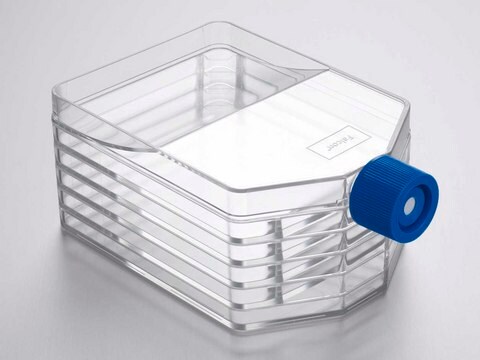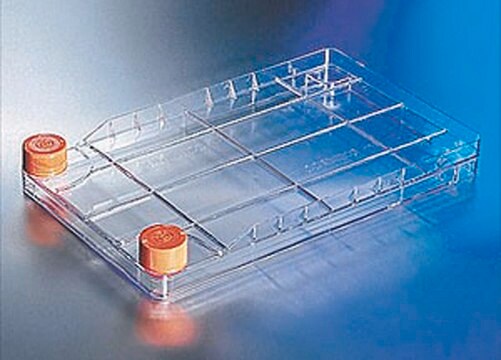PFHYS0616
Millicell® HY Multilayer Culture Flask
T-600, 3 layer, 120-180 mL, sterile, vented cap, Tissue Culture (TC)-treated surface
Synonim(y):
High Yield Culture Flask, Millicell HY Flask T-600 Cell Culture Flask, cell culture, cell culture flask, multi-layer flask, tissue culture
About This Item
Polecane produkty
Materiały
angled neck high-density polyethylene cap (vented)
polystyrene flask
Poziom jakości
sterylność
sterile; γ-irradiated
Właściwości
3 layer
opakowanie
pack of 16
producent / nazwa handlowa
Millicell®
Parametry
45 °C max. temp.
metody
cell culture | mammalian: suitable
Wysokość
32 mm , excluding cap
51 mm , including cap
Długość
22.2 cm
Szerokość
12 cm
powierzchnia
600 cm2
pojemność robocza
120-180 mL
typ wiązania
Tissue Culture (TC)-treated surface
Warunki transportu
ambient
Uwaga dotycząca przygotowania
- To seed cells, fill the Millicell HY T-600 Flask with the desired growth media.
- Add desired number of cells to achieve typical seeding density.
- Mix the cells and media by raising the end of the flask and pipetting the solution up and down several times until a homogeneous suspension is achieved. Note: Failure to adequately mix cells into a homogeneous suspension may result in an uneven distribution of cells across the layers of the Millicell HY Flask.
- Briefly lay the flask on its side to equilibrate the liquid volume equally among the layers of the flask.
- Tilt the flask on its end to partition the liquid volume for each layer of the flask.
- Lay the flask down to spread the cell suspension evenly across the entire surface of each layer.
- Depending on the volume it may be necessary to rock the flask on all four corners to ensure that the entire surface wets. Note: If the liquid volume on any of the layers changes during the wetting procedure (e.g., spilling of liquid from top layer to lower layers), repeat steps 4–6 to ensure even distribution of liquid among all layers.
- Return the flask to a vertical position when transporting to the incubator. Lay the flask flat in the incubator (as in step 6) and culture cells under appropriate conditions.
- If media exchange is required, either aspirate or pour the media from the Millicell HY T-600 Flask. Note: Due to the larger surface area of the Millicell Flasks, it may be necessary to let the flask stand on its side for several minutes following each aspiration so that all residual liquid pools to a common point, allowing for a second aspiration to completely remove the remaining liquid.
- Add appropriate volume of fresh media, and repeat steps 4–8.
- To harvest cells, remove media as in step 9.
- Add desired amount of appropriate wash solution (e.g., PBS or 0.02% EDTA) to the flask and repeat steps 4–7.
- Remove wash solution as in step 9.
- Add desired amount of dissociation enzyme (e.g., 0.25% trypsin/EDTA or equivalent) according to preferred protocol, repeat steps 4–8, and incubate. Volume of dissociation enzyme required per cm2 does not need to be altered from T-flask protocol. Note: Ensure that all cells have completely dissociated from the surface of the flask via observation under microscope. Failure to allow complete dissociation of cells from culture surface (such that all cells are freely floating) may result in reduced cell yields.
- If using trypsin, add desired volume of inactivating solution, such as serum-containing media.
- Collect cells either by aspirating or pouring, as in step 9.
Informacje prawne
polecane
produkt podobny
Certyfikaty analizy (CoA)
Poszukaj Certyfikaty analizy (CoA), wpisując numer partii/serii produktów. Numery serii i partii można znaleźć na etykiecie produktu po słowach „seria” lub „partia”.
Masz już ten produkt?
Dokumenty związane z niedawno zakupionymi produktami zostały zamieszczone w Bibliotece dokumentów.
Klienci oglądali również te produkty
Powiązane treści
Monitoruj swoje hodowle komórkowe z łatwością dzięki Millicell® DCI Digital Cell Imager. Od konfluencji do liczby komórek i morfologii, Millicell® DCI automatyzuje pomiary hodowli komórkowej w celu szybszej i bardziej spójnej hodowli.
Nasz zespół naukowców ma doświadczenie we wszystkich obszarach badań, w tym w naukach przyrodniczych, materiałoznawstwie, syntezie chemicznej, chromatografii, analityce i wielu innych dziedzinach.
Skontaktuj się z zespołem ds. pomocy technicznej








